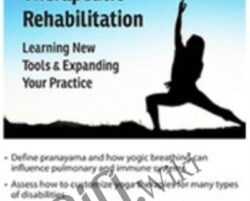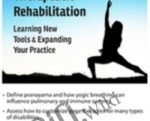Yoga Applications across the LifespanYoga has become increasingly popular in the western mainstream world these days, but its therapeutic applications are relatively unknown to most rehabilitation clinicians. This recording is specifically designed for therapists! You will expand your therapeutic repertoire and improve client functions through incorporating yoga in nearly any setting. This material is highly useful for both adult and pediatric clients, and it can be used to assist with pain management too. In fact, yoga therapy can be used with the clients therapists struggle most to help!Yoga for Therapeutic Rehabilitation will tap into your knowledge of anatomy and physiology (not to mention a little psychology) in order to enhance treatment plans for clients with issues ranging from multiple sclerosis and cancer to cerebral palsy, spinal cord injury, and many orthopedic and neurological disorders. You will discover innovative ways to use props and equipment to assist your clients’ therapeutic outcomes. You will view group breakout sessions in which you will discover ways to maximize function using yoga postures for clients in a wide array of settings. By incorporating yoga into your therapeutic practice, you will begin to see health care in a whole new, expanded way. Do not miss this exciting opportunity to bring yoga as a treatment modality to your clients.This recording is designed for people of all skill levels. You do not need to be experienced with yoga to be able to watch this recording or integrate its benefits with clients!Discover how yoga can enhance the muscular, nervous, and cognitive systems for both pediatric and adult clients.Practice restorative and active poses, outlining what props to use for various poses and why.Describe how yogic breathing can influence pulmonary and immune systems.Convey how yoga therapy is able to alleviate pain.Cite ways that yoga can provide therapeutic benefits to improve muscular and joint stability.Explain the difference between active and restorative poses and list the therapeutic benefits of each.Correctly determine how to position a client with a disability using restorative poses.Identify how positioning and pranayama can improve your clients’ overall wellness.Demonstrate how to use basic yoga poses, sequences, and deep relaxation using props for modification depending on client’s diagnosis.Create customized client treatment plans that incorporate yoga.Why Yoga as a Therapeutic Modality?What is yoga?Understand Integrative MedicineReview body systems and how they work togetherUnderstand types of yoga and how yoga therapy aids body systemsNeuroplasticity of the brain and eye, and brain exercises for adults and kidsThe Nervous System and pain controlHow yoga comforts pain clientsAnatomy of Therapeutic Yoga: Cardiopulmonary SystemReview pulmonary anatomy (case study)Proper breathing and its benefitsTypes of pranayamaBreathing exercisesTherapeutic breathing and your adults and kidsWhen to use pranayama for adults and kidsDefine breathing and positioninguprightside-lying in bedwheelchairstandingCase study with group practice of pranayama, seated and standing pose demoAnatomy of Therapeutic Yoga: Musculoskeletal SystemPosture and nerve and muscle communicationAnatomy of the shoulder and hip jointsOpening the joint door: muscle and body balancePractical applications for diagnosesSecondary disabilities and their consequences, dissecting the mechanics of movementspasticityhypotonicitymuscle imbalanceYoga as medicine for adults and kids from dependent clients to active clientsAsana Application and TreatmentAsana posesThe science of restorative vs. active poses and the body’s responseDecide between restorative vs. active poses for treatmentCase studies in a variety of settings from hospitals to schoolsPerform active posesPoses: Props and Our PatientsPerform restorative posesHow do resting poses help clients with disabilities? (client with cancer case study)The importance of elongation and extension of the body and how props assist your clientsPictures of supported and active yoga poses for clients with a variety of disabilitiesProps for therapeutic use with spasticity, abnormal tone, weakness, or imbalanceHow do you decide if your client needs resting or active poses and how much?Is the client prone, supine, or in a wheelchair?Pose Lab and Case Study PresentationsPractice poses and experience the therapeutic benefits of a restorative pose vs. an active poseUsing props through visuals and posesExamine 5 different case studies and determine what poses are best for your clientsTherapeutic benefits of each pose for each diagnosis and their contraindicationsWhat props to use for each pose and whyYoga and Expanding Client TreatmentIn your setting: acute care, inpatient, outpatient, home health, and hospiceThroughout the lifespanGiving the client a gift in the communityRecent studies in medicine and yogaYoga and its future in health careYoga and the Integrative Medicine teamTag: Yoga for Therapeutic Rehabilitation: Learning New Tools & Expanding Your Practice – Betsy Shandalov Review. Yoga for Therapeutic Rehabilitation: Learning New Tools & Expanding Your Practice – Betsy Shandalov download. Yoga for Therapeutic Rehabilitation: Learning New Tools & Expanding Your Practice – Betsy Shandalov discount
 Life Hack: How to Live Rent-Free in NYC – Become Financially – Roberto Gonzalez
₹5,478.00
Life Hack: How to Live Rent-Free in NYC – Become Financially – Roberto Gonzalez
₹5,478.00
 Learn Ruby Programming The Easy Way Deal
₹5,478.00
Learn Ruby Programming The Easy Way Deal
₹5,478.00
Yoga for Therapeutic Rehabilitation: Learning New Tools & Expanding Your Practice – Betsy Shandalov
₹12,450.00




